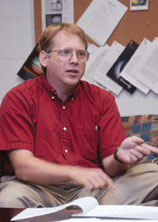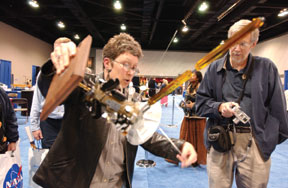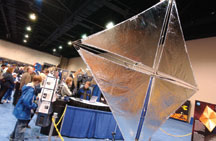![]() Current Issue
Current Issue
(Fall 2005)
Cosmic Wonders
What is the strange arrowhead feature on Saturn's largest moon, Titan? What can its methane lakes tell us about the development of early Earth? Why is Titan the only celestial body in the solar system except for Earth to have an atmosphere?
Scientests from all over the world converged on Louisville to ponder these questions and more the week of Nov. 8 as they discussed the latest findings of one of the most exciting space mission in years.
Nearly 700 planetary experts came to the city to hold their 36th annual meeting of the American Astronomical Society's Division for Planetary Sciences. The meeting was in Louisvlle for the first time thanks largely to the persuasive efforts of Tim Dowling, a leading authority on planetary atmospheres and director of U of L's Comparative Planetology Laboratory in the mechanical engineering department at Speed School.

Speed professor Timothy Dowling persauded fellow planetary scientists to convene in Louisville.
What the scientists came to talk about primarily was the NASA and European Space Agency's Cassini-Huygens mission to Saturn and its moons, which is reaching its apex this winter as the Cassini space-craft launches the Huygens probe to the enigmatic surface of Titan. The mission promises to beam back data that may tell researchers much about the development of the solar system and its planets, including Earth.
Dowling says he was pleased that some of the world's most prominent space scientists came to Louisville, including D.L. Matson, head scientist in charge of the Cassini mission at NASA's Jet Propulsion Laboratory in California.
"This was an especially exciting year for the conference because it happened just as data was coming in from major planetary sciences in general, not just from Cassini but from the Mars rovers and the orbiting Spitzer Space Telescope as well. From the Spitzer telescope, for example, we've just seen some gorgeous images of comet dust tails from all over the solar system.
Part of the goal of this year's conference was to share the excitement of space discovery with the public. In addition to formal presentations among scientists, the conference included public exhibits and events for people of all ages.

Among the conference attendees were Jane Houston Jones, of NASA's Jet Propulsion Laboratory, who demonstrated the workings of spacecraft in the space conference's public exhibit area.
"We're here for two audiences," said Matson on the conference's first night. "One audience is those who don't know about the mission and the other is people who do know and want to see what's new."
Matson says he wants the public to realize that space exploration has many dimensions. "We're exploring part of our environment that we haven't seen before, and I do consider the solar system part of the environment because what we learn about Saturn and its moons may prove useful here on Earth," Matson says. "What we learn about weather on Titan, for example, could help us in forecasting it on Earth."
"Physics and chemistry are the same everywhere," he continues. "By seeing details of Saturn's rings we can learn more about physics, mechanics and atmospheres and better understand how early Earth's chemistry developed."
Among the companies and agencies with public exhibits at the conference were NASA, Boeing, Ball Aerospace and Technologies, Lockheed Martin, Johns Hopkins, Cambridge University Press and the Space Science Institute.

A solar sail was one of the many public displays at the recent planetary sciences conference in Louisville.
More than 700 area school children enjoyed the event's displays of model rockets, meteorites, a solar sail, space telescopes and more.
Dowling says he is encouraged by scientists' responses to Louisville. The researchers came from places as far afield as France, Russia and Japan and "found the city charming," he says. "This really puts Louisville on the map," he adds.
An expert on planetary gases and atmospheres, Dowling is involved in several studies, including a comparison of the atmospheres of Venus and Titan and of Jupiter and Saturn. He is one of several U of L professors conducting space research. U of L scientists have been working with NASA and conducting other space-related research for decades. In 2003, they received $3 million in NASA contracts. With a renewed emphasis on space exploration and a new partnership between Kentucky and NASA, more research opportunities could be forthcoming.
Speed School mechanical engineering professor Keith Sharp is studying the effects of weightlessness on blood circulation and a condition known as "postflight orthostatic intolerance," or the inability of astronauts to stand after they return to Earth. Sharp recently received two grants from NASA and the National Science Foundation to continue his work.
In other departments at U of L, biochemstry professor Eugenia Wang and physics professor John Kielkopf also conduct space-related research. She is studying the long-term effects of space travel and Kielkopf is examining theories related to white dwarf stars and comets. Physics graduate Mark Wadsworth helped design imaging and navigation systems for the Mars rovers Spirit and Opportunity
Read more about the space research being conducted by Dowling, Sharp and others at U of L by linking to the summer 2004 issue of UofL Magazine.
Also, learn more at the Comparative Planetology Laboratory's web site.